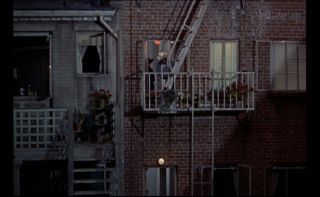The MacGuffin: News and Comment (02/Aug/2008)
(c) Ken Mogg (2008)
August 2
Books on film storytelling are legion (one that came here recently was Howard Suber's well-regarded 'The Power of Film'), but Yves Lavandier's 'La Dramaturgie' has become something of an institution in France and is now available in English as 'Writing Drama'. As my review of Lavandier's book on this site makes clear, I hope, I find much that is admirable in it. Also, it shows a good knowledge of Hitchcock's films. But something about Rear Window (1954) puzzles Lavandier. Today I'll try to answer the question he poses there. He asks: why was it necessary to show Thorwald (Raymond Burr) leaving his apartment with 'a woman in black it is impossible to identify, [followed by] a return pan to Jeff (James Stewart) asleep'? (See frame-capture below.) Earlier, we and Jeff had several times watched Thorwald by himself leaving and returning to his apartment in the rain, each time carrying a suitcase. But this extra shot 'is a source of confusion. It combines dramatic irony, at Jeff's expense, and mystery, since we are in the dark, as regards the woman in black. ... [Accordingly] we are no longer on the same footing as the protagonist and it is hard for me to identify with him [thereafter] ... [Hitchcock and screenwriter John Michael Hayes have planted] a seed of doubt. Why did they do this? I have no idea.' (p. 292) My answer to this will be threefold. Firstly, I do think we need to feel that maybe the woman in black was Thorwald's wife, whom Jeff suspects has been murdered. We need this visual reminder that Jeff and Lisa (Grace Kelly) may be making fools of themselves when they tell Doyle (Wendell Corey) their suspicions. Otherwise, if we knew only as much as Jeff and Lisa, we might soon grow impatient with them, and say, 'Come on, chuck it! It's only a mystery! Pay more attention to each other!' (Jeff has all along been wary of marrying the 'too perfect' Lisa.) But, paradoxically, because of the nagging question in our minds about what really happened in Thorwald's apartment, our interest in the mystery is actually deepened. Secondly, it wouldn't do to have Jeff see the woman in black. For then his descriptions to Lisa and Doyle of all that he had seen would become wordy and cumbersome. Thirdly, there's this. Later in the film there's another shot of Thorwald leaving his apartment unseen by Jeff, namely, when he, Thorwald, is heading Jeff's way for a showdown. Hitchcock always liked to set up key moments by leading up to them. (For example, in Strangers on a Train, there's the red-herring of a girl screaming in the Tunnel of Love before, soon afterwards, another girl, Miriam, really is killed. The earlier scream had helped prepare us for what follows.) Hitchcock called this 'taking the curse off' such moments. When we see Thorwald heading Jeff's way, unnoticed by Jeff - who at this moment is talking with Stella (Thelma Ritter) - we anticipate danger and inwardly groan at Jeff, 'Oh not again! You always miss seeing what is important!' But this is better dramatically than if there had been no audience-preparation by the earlier shot. It stops us noticing how the shot of Thorwald is a 'bogey man' shot, saying to us, 'Watch out! Your hero is in danger!' If we are too aware of the film's mechanics, there is always the likelihood of our becoming cynical about how we are being manipulated, leading to a loss of involvement. I'll have more to say about Yves Lavandier's book 'Writing Drama' next time.
This material is copyright of Ken Mogg and the Hitchcock Scholars/'MacGuffin' website (home page) and is archived with the permission of the copyright holder. |

